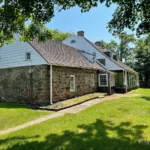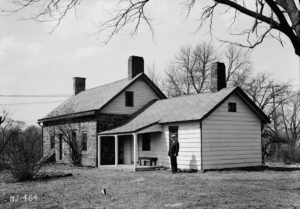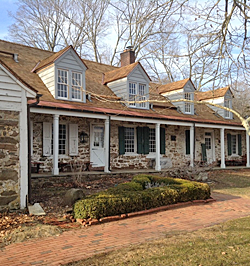Schuyler-Colfax House Museum
 In 1695, Arent Schuyler travelled from Albany, New York to northern New Jersey, part of an eight man group planning to negotiate with indigenous, Munsee speaking peoples for land rights in the region. Schuyler, one of eight children born to Philip Pieterse Schuyler and Margarita Van Slichtenhorst, was the de facto leader of the group, owing to his prior experience with Native Americans- likely the Mahican, or Mohican, tribes, and the Mohawk people- as a fur trader. On June 6th, 1695, Schuyler agreed to the rights to 5,500 acres in exchange for wampum and varied goods valued at 250 English pounds. A portion of land was divided amongst the eight. On his lot, overlooking the Ramapo River, Schuyler built a one-story, two bay fieldstone home, typical of early Dutch construction. This home eventually expanded into the Schuyler-Colfax House.
In 1695, Arent Schuyler travelled from Albany, New York to northern New Jersey, part of an eight man group planning to negotiate with indigenous, Munsee speaking peoples for land rights in the region. Schuyler, one of eight children born to Philip Pieterse Schuyler and Margarita Van Slichtenhorst, was the de facto leader of the group, owing to his prior experience with Native Americans- likely the Mahican, or Mohican, tribes, and the Mohawk people- as a fur trader. On June 6th, 1695, Schuyler agreed to the rights to 5,500 acres in exchange for wampum and varied goods valued at 250 English pounds. A portion of land was divided amongst the eight. On his lot, overlooking the Ramapo River, Schuyler built a one-story, two bay fieldstone home, typical of early Dutch construction. This home eventually expanded into the Schuyler-Colfax House.
As with the Mead-Van Duyne and the Van Riper-Hopper House, the Schuyler-Colfax House passed through the hands of various family members and underwent construction over the years. Arent Schuyler married three times – Jenneke Teller (m. 1684), Swantje Duykuisen (m. 1700), and Maria Walters (m. 1724) – and fathered twelve children. When he moved out of the Schuyler-Colfax House in 1710, he left the home and surrounding property to one of his children with Teller; Philip Schuyler (ca. 1687 to 1763). Schuyler was involved in local government as a representative in the New Jersey colonial legislature and a Bergen County freeholder, and he ran the nearby Pompton Ironworks. He and his wife, Hester Kingsland, had twelve children, among them Hester Schuyler, who married Theunis Dey of the Dey Mansion. Philip Schuyler’s 1760 will left the house and 200 acres to his youngest son, Casparus, who passed the property onto his only child, Esther in 1795.
533 Berdan Ave, Wayne, NJ 07470


